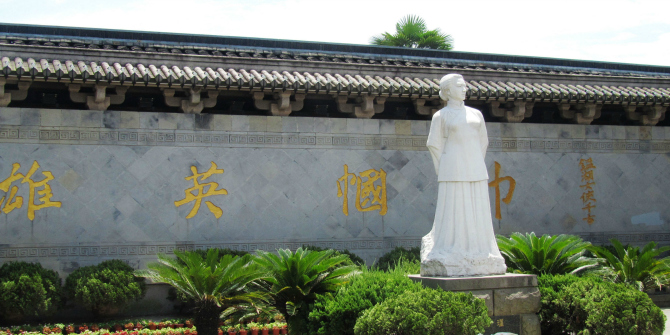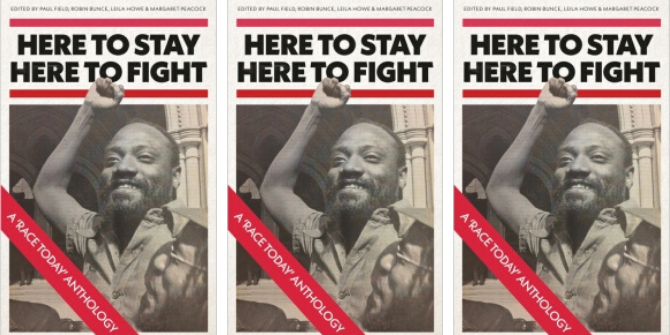Author Shanthini Naidoo reflects on her decision to change the focus of her Master’s dissertation in order to uncover the narratives of anti-apartheid women activists in South Africa. This research formed the basis of her recently published book Women in Solitary: Inside the Female Resistance to Apartheid, which focuses particularly on four women: Joyce Sikhakhane-Rankin, Shanthie Naidoo, Nondwe Mankahla and Rita Ndzanga. As the UK celebrates Black History Month in October, Naidoo reflects on the importance of uncovering stories that not only evidence bravery and courage, but also the power of love and friendship in daily life.
Writing Women in Solitary: Shifting Narratives to Make Research Count

The Journalism faculty at the University of the Witwatersrand is on the tenth floor of a tall tower, with a glass-walled spherical room at the top which resembles a spaceship. It gives a 360°, birds-eye view of the city of Johannesburg, where I live. It was always a pleasure to learn in that space because it served as a physical reminder that as students, we would need to rise to great heights to get through our Master’s studies. And it felt as if the journey I’d embarked on was meant for a higher purpose.
Initially convinced that I would produce a thesis heavily focused on research and analytics was also a lofty idea, my aim being to dissect the digitisation of print media and seek solutions for the demise of my craft in South Africa and abroad. The topic was wearying, despite the project being already in its tangible proposal phase, because I knew the answer would not make a dent in the work; it would simply highlight a dire problem.
Then, on 2 April 2018, a South African stalwart, Winnie Madikizela-Mandela, died.
The obituaries and editorials in South Africa and abroad called her a philanderer, a militant, a rogue, Nelson’s wife. It was an unfair and biased account of a long and complicated life. What about her role as a country leader, the mother of two young girls who was thrown into prison then banished to a barren town for periods, an estranged wife for 27 years?
Reporting on her death, I decided to change my research topic in a hurry, with great encouragement from my supervisor, Professor Lesley Cowling. I wanted to look at how the narratives of female activists were recorded in South African and global history. It was research that was scarce. Yet, the detail it uncovered was so intriguing that two years later the thesis would be selected to be published as a book, once I’d expanded on the narrative. It became Women in Solitary: Inside the Female Resistance to Apartheid, published in 2020 by Tafelberg.

Finding the story
Researching Winnie Madikizela-Mandela’s time in prison, I found that seven women were imprisoned in 1969 at the same time as her. They were political prisoners, activists for the African National Congress (ANC) who were kept in solitary confinement: invisible, tortured in conditions even worse than the leaders of the anti-apartheid movement experienced on the Robben Island prison, off the coast of Cape Town. Few knew of these women today: Joyce Sikhakhane-Rankin, Shanthie Naidoo, Nondwe Mankahla and Rita Ndzanga, who are still alive. And two others, Thoko Mngoma and Martha Dhlamini, who had passed on.
For two years, I captured the herstory, recording the experiences of four South African heroines that would have otherwise gone untold: journalist Sikhakhane-Rankin, trade unionists Ndzanga and Naidoo (no relation, but serendipitous coincidence) and activist Mankahla. The women were involved in the clandestine organising of the ANC in South Africa. Given freedom of movement as a journalist, Sikhakhane-Rankin served as a messenger for high-profile members of the movement who were not allowed to meet. She also wrote about the lives of ordinary South Africans who were impacted by apartheid, informing the international community about the human rights abuses inflicted on people by the government of the time.
Ma Ndzanga, as she was known, was involved in smuggling young people into exile and to the ANC training camps in other parts of Africa. For this, she was often detained and brutally beaten to reveal her network. Her husband, Lawrence, was killed in one of those detentions and she was not allowed to attend his funeral. Meanwhile, Naidoo and her family were involved in recruiting and harbouring banned comrades, planning protests and acts of defiance. Mankahla was also a messenger for ANC leaders, hiding secret messages in the newspapers and fruit she sold.
For these collective acts of maintaining a banned movement, the women were regarded as terrorists by the apartheid government. Along with Madikizela-Mandela, they were detained in solitary confinement for over a year, and interrogated (read: tortured physically and mentally) in an attempt to elicit statements against each other. They refused, and what was called the ‘Trial of 22’ in 1969 collapsed.
South Africans don’t readily recognise their names or the name of the trial, 50 years later. Our history was lost, in destroyed archives and suppressed narratives from the time. And it was a researched anomaly that in South Africa, men’s narratives of activism were always given precedence over those of women.
But the impact of the 1969 trial shaped South Africa’s democracy in many ways. If the women had given in to their captors, turning on each other, they would have been jailed for life. If Madikizela-Mandela had been imprisoned for decades like the Robben Island prisoners, who knows how the South African democracy story would have unfolded?
Healing through storytelling
The story in Women in Solitary centres on a single trial, but it is also about how these women picked up their lives and loves after solitary confinement, the thrilling tales of their escape to exile and their continued activism thereafter. Sikhakhane-Rankin was smuggled across borders to Germany and then Britain. She settled in Scotland with her husband, surgeon Ken Rankin (OBE), from where their work in the anti-apartheid movement continued. The pair returned to Africa to carry out operations for the movement, including gun smuggling as it became an armed struggle. Sikhakhane-Rankin went underground as a soldier for periods while a mother of five, including two children who were born in Scotland.
Accepted as a refugee by the British government, Naidoo was involved in the thriving anti-apartheid movement in the UK, which staged protests and often camped outside South Africa House in London to encourage the government to intervene and increase sanctions against South Africa, in an attempt to discourage apartheid laws. UK activists also helped to provide legal representation for political activists through the London-based International Defence and Aid Fund, where Naidoo worked for many years, having settled in Walmington Fold, London, until 1991 when South Africa was liberated.
The story in Women in Solitary is the detail of the four women’s lives, their activism, their mental wellbeing and how their children and grandchildren – who are our contemporaries and colleagues – were affected by their work.
The reason for recording this story now is that, like many global matters of significance, the most significant war in South Africa’s recent history was largely fought in the mind. It was a psychological, classist and racial battle from which we are yet to emerge. There are many parallels in the world right now. Black Lives Matter, #MeToo and more have shown us how much we need to connect to the strength of where we have come from in order to heal.
These women, and others around the world, are the way-finders in the struggles we face today and those yet to come. They taught us to stand on the side of the good, that each of us is a force, and that together we have immeasurable strength. As gender activist and special rapporteur for the United Nations Human Rights Council, Dr Tlaleng Mofokeng, wrote for the blurb of Women in Solitary: ‘By elevating the many untold stories and lives of women in the struggle for democracy, we are stirred with visceral emotions because we are these women, and they are us.’ This applies even more in the framing of Black history.
When we remember those who came before us through simple storytelling, we have a tool for healing generational wounds which affect us today. Research has suggested that trauma may be carried through generations. But research has also suggested that we can tackle painful histories and experiences with storytelling. Storytelling promotes healing from the past, but also in the present, the need for which is so prevalent and heightened by the COVID-19 pandemic.
If not I, then who?
First, we have to know the stories. The detail of our history is valuable. To know about the positive, hopeful stories is important, not only for the bravery and courage shown, but for the love and friendship that can be found in lives and daily existence while the wheels of history turn. These stories give us hope and resilience.
It is why academic work of significance should make us strive for a higher purpose than simply adding to our personal achievements and carving pathways in our careers. They must be valuable with deep meaning, and when we take a bird’s-eye view at the end, we can see that we have made a difference.
Note: This feature essay gives the views of the author, and not the position of the LSE Review of Books blog, or of the London School of Economics.
Image Credit: Photograph of University Corner building, which houses the Journalism faculty at the University of the Witwatersrand. Image provided courtesy of © University of the Witwatersrand. Thank you to Shanthini Naidoo and the University of the Witwatersrand for their help in providing the image.







